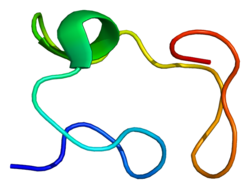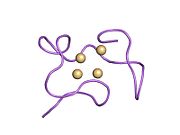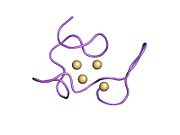Metallothionein 2A
Metallothionein-2 is a metallothionein protein that in humans is encoded by the MT2A gene.[3][4]
The single-nucleotide polymorphism rs28366003 which substitutes guanine for adenine in MT2A is associated with certain cancers and some chronic diseases.[5]
Interactions
[edit]Metallothionein 2A has been shown to interact with protein kinase D1.[6]
References
[edit]- ^ a b c GRCh38: Ensembl release 89: ENSG00000125148 – Ensembl, May 2017
- ^ "Human PubMed Reference:". National Center for Biotechnology Information, U.S. National Library of Medicine.
- ^ Karin M, Richards RI (Dec 1982). "Human metallothionein genes--primary structure of the metallothionein-II gene and a related processed gene". Nature. 299 (5886): 797–802. Bibcode:1982Natur.299..797K. doi:10.1038/299797a0. PMID 7133118. S2CID 4332683.
- ^ "Entrez Gene: MT2A metallothionein 2A".
- ^ Sekovanić A, Jurasović J, Piasek M (2020). "Metallothionein 2A gene polymorphisms in relation to diseases and trace element levels in humans". Arhiv Za Higijenu Rada I Toksikologiju. 71 (1): 27–47. doi:10.2478/aiht-2020-71-3349. PMC 7837243. PMID 32597135.
- ^ Rao, Prema S; Jaggi Meena; Smith David J; Hemstreet George P; Balaji K C (Oct 2003). "Metallothionein 2A interacts with the kinase domain of PKCmu in prostate cancer". Biochem. Biophys. Res. Commun. 310 (3). United States: 1032–8. doi:10.1016/j.bbrc.2003.09.118. ISSN 0006-291X. PMID 14550308.
Further reading
[edit]- Kissling MM, Kägi HR (1977). "Primary structure of human hepatic metallothionein". FEBS Lett. 82 (2): 247–50. Bibcode:1977FEBSL..82..247K. doi:10.1016/0014-5793(77)80594-2. PMID 913597. S2CID 46396323.
- Yamazaki S, Nakanishi M, Hamamoto T, et al. (1993). "Expression of human metallothionein-II fusion protein in Escherichia coli". Biochem. Int. 28 (3): 451–60. PMID 1339282.
- Messerle BA, Schäffer A, Vasák M, et al. (1992). "Comparison of the solution conformations of human [Zn7]-metallothionein-2 and [Cd7]-metallothionein-2 using nuclear magnetic resonance spectroscopy". J. Mol. Biol. 225 (2): 433–43. doi:10.1016/0022-2836(92)90930-I. PMID 1593628.
- Zafarullah M, Martel-Pelletier J, Cloutier JM, et al. (1992). "Expression of c-fos, c-jun, jun-B, metallothionein and metalloproteinase genes in human chondrocyte". FEBS Lett. 306 (2–3): 169–72. Bibcode:1992FEBSL.306..169Z. doi:10.1016/0014-5793(92)80992-P. PMID 1633872. S2CID 43460076.
- Messerle BA, Schäffer A, Vasák M, et al. (1990). "Three-dimensional structure of human [113Cd7]metallothionein-2 in solution determined by nuclear magnetic resonance spectroscopy". J. Mol. Biol. 214 (3): 765–79. doi:10.1016/0022-2836(90)90291-S. PMID 2388267.
- Duguid JR, Bohmont CW, Liu NG, Tourtellotte WW (1989). "Changes in brain gene expression shared by scrapie and Alzheimer disease". Proc. Natl. Acad. Sci. U.S.A. 86 (18): 7260–4. Bibcode:1989PNAS...86.7260D. doi:10.1073/pnas.86.18.7260. PMC 298037. PMID 2780570.
- Karin M, Haslinger A, Heguy A, et al. (1987). "Metal-responsive elements act as positive modulators of human metallothionein-IIA enhancer activity". Mol. Cell. Biol. 7 (2): 606–13. doi:10.1128/mcb.7.2.606. PMC 365115. PMID 3821726.
- Karin M, Haslinger A, Holtgreve H, et al. (1984). "Characterization of DNA sequences through which cadmium and glucocorticoid hormones induce human metallothionein-IIA gene". Nature. 308 (5959): 513–9. Bibcode:1984Natur.308..513K. doi:10.1038/308513a0. PMID 6323998. S2CID 4357363.
- Schmidt CJ, Hamer DH, McBride OW (1984). "Chromosomal location of human metallothionein genes: implications for Menkes' disease". Science. 224 (4653): 1104–6. Bibcode:1984Sci...224.1104S. doi:10.1126/science.6719135. PMID 6719135.
- Karin M, Richards RI (1982). "Human metallothionein genes: molecular cloning and sequence analysis of the mRNA". Nucleic Acids Res. 10 (10): 3165–73. doi:10.1093/nar/10.10.3165. PMC 320698. PMID 6896577.
- Lambert E, Kille P, Swaminathan R (1996). "Cloning and sequencing a novel metallothionein I isoform expressed in human reticulocytes". FEBS Lett. 389 (2): 210–2. Bibcode:1996FEBSL.389..210L. doi:10.1016/0014-5793(96)00587-X. PMID 8766831. S2CID 8195335.
- Woo ES, Dellapiazza D, Wang AS, Lazo JS (1999). "Energy-dependent nuclear binding dictates metallothionein localization". J. Cell. Physiol. 182 (1): 69–76. doi:10.1002/(SICI)1097-4652(200001)182:1<69::AID-JCP8>3.0.CO;2-9. PMID 10567918. S2CID 31787611.
- Jiang LJ, Vasák M, Vallee BL, Maret W (2000). "Zinc transfer potentials of the alpha - and beta-clusters of metallothionein are affected by domain interactions in the whole molecule". Proc. Natl. Acad. Sci. U.S.A. 97 (6): 2503–8. Bibcode:2000PNAS...97.2503J. doi:10.1073/pnas.97.6.2503. PMC 15958. PMID 10716985.
- Garrett SH, Sens MA, Shukla D, et al. (2000). "Metallothionein isoform 1 and 2 gene expression in the human prostate: downregulation of MT-1X in advanced prostate cancer". Prostate. 43 (2): 125–35. doi:10.1002/(SICI)1097-0045(20000501)43:2<125::AID-PROS7>3.0.CO;2-S. PMID 10754528. S2CID 8768274.
- Ebert MP, Günther T, Hoffmann J, et al. (2000). "Expression of metallothionein II in intestinal metaplasia, dysplasia, and gastric cancer". Cancer Res. 60 (7): 1995–2001. PMID 10766190.
- Toyama M, Yamashita M, Hirayama N, Murooka Y (2003). "Interactions of arsenic with human metallothionein-2". J. Biochem. 132 (2): 217–21. doi:10.1093/oxfordjournals.jbchem.a003213. PMID 12153718.
- Sun X, Kang YJ (2002). "Prior increase in metallothionein levels is required to prevent doxorubicin cardiotoxicity". Exp. Biol. Med. (Maywood). 227 (8): 652–7. doi:10.1177/153537020222700815. PMID 12192109. S2CID 45099558.
- Strausberg RL, Feingold EA, Grouse LH, et al. (2003). "Generation and initial analysis of more than 15,000 full-length human and mouse cDNA sequences". Proc. Natl. Acad. Sci. U.S.A. 99 (26): 16899–903. Bibcode:2002PNAS...9916899M. doi:10.1073/pnas.242603899. PMC 139241. PMID 12477932.
- Izmailova E, Bertley FM, Huang Q, et al. (2003). "HIV-1 Tat reprograms immature dendritic cells to express chemoattractants for activated T cells and macrophages". Nat. Med. 9 (2): 191–7. doi:10.1038/nm822. PMID 12539042. S2CID 26145639.


 French
French Deutsch
Deutsch



![1mhu: THE THREE-DIMENSIONAL STRUCTURE OF HUMAN [113CD7] METALLOTHIONEIN-2 IN SOLUTION DETERMINED BY NUCLEAR MAGNETIC RESONANCE SPECTROSCOPY](http://upload.wikimedia.org/wikipedia/commons/thumb/c/cb/PDB_1mhu_EBI.jpg/180px-PDB_1mhu_EBI.jpg)


![2mhu: THE THREE-DIMENSIONAL STRUCTURE OF HUMAN [113CD7] METALLOTHIONEIN-2 IN SOLUTION DETERMINED BY NUCLEAR MAGNETIC RESONANCE SPECTROSCOPY](http://upload.wikimedia.org/wikipedia/commons/thumb/8/86/PDB_2mhu_EBI.jpg/180px-PDB_2mhu_EBI.jpg)